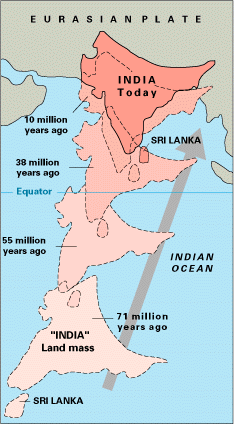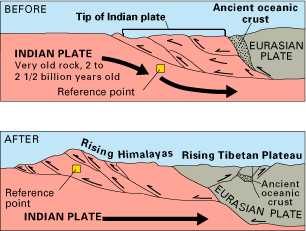
Moultonborough Academy, Moultonborough, New Hampshire
The Five Themes of Geography Meet the Himalayan Region
REGION
Curriculum Standard: SS:GE:12:3.1 “Students will explain the interaction of Earth's physical systems. e.g. tectonic forces that shape continents and ocean basins. www.ed.state.nh.us/frameworks
The Himalayan Region has continued to grow taller with the movement of tectonic plates. Below, you can see the movement of India that continues to contribute to the growth of the region.
 |
Millions of years ago, India was located off of the Australian coast. Due to the split of Pangea, India started moving. You can follow its movement north into the Eurasian Plate. When India slowed this movement, the Himalayas started growing. According to scientists, the Himalayas are now only rising at 1cm a year and they believe that the Eurasian plate is stretching out rather than moving up. Tectonic plates are moving parts of Asia east toward the Pacific. These stresses are causing major earthquakes there. |
Like two icebergs colliding, the plates push the crust up rather than sliding over one another. The above illustrations show the meeting of the plates before and after collision. The Himalayas are the highest continental mountains in the world. And, the Tibetan Plateau is higher than most of the peaks in the Alps and most of the mountains in the U.S. ASSIGNMENT: You have located the Himalayan Region on your map of the world. Now, find your South Asia map and return to the group that you had for that map. Each group will gather colored pencils and a large blank outline map of the region. Your group will transfer the information from your small maps to the larger one, keeping in mind that you will be adding more information to the larger map as we go along. Once you have finished transferring the information, locate and label the following: Tibetan Plateau, Himalayas, Hindu Kush, Karakorum, Tien Shan, Ganges River, Taklimakan Desert, Gobi Desert, Thar Desert, and Yolmo Valley. You have now started your "Big Map" of the Himalayan Region. |
